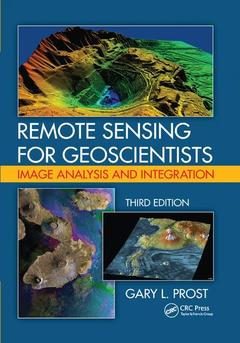Description
Remote Sensing for Geoscientists (3rd Ed.)
Image Analysis and Integration, Third Edition
Author: Prost Gary L.
Language: English
Subjects for Remote Sensing for Geoscientists:
Keywords
Remote Sensing; Airborne Lidar; Spot Image; geoscience; Hyperspectral Imagery; photointerpretation; Google Earth; remote sensing systems; Relay Ramps; geothermal resource exploitation; Strike Slip Faults; surface water monitoring; Lidar Datasets; geologic mapping; Decorrelation Stretch; Moon Mineralogy Mapper; Thrust Faults; Side Scan Sonar; Eros Data Center; AMSU; Lava Ows; Color Infrared Imagery; Sea Surface Height; Pe Rc; Sea Grass; Hydrothermal Uids; Meris Instrument; USDA Farm Service Agency; Porphyry Copper Deposits; Mars Reconnaissance Orbiter; Fracture Zones
Publication date: 12-2019
· 17.8x25.4 cm · Paperback
Publication date: 12-2013
· 17.8x25.4 cm · Hardback
Description
/li>Contents
/li>Biography
/li>
This third edition of the bestselling Remote Sensing for Geologists: A Guide to Image Interpretation is now titled Remote Sensing for Geoscientists: Image Analysis and Integration. The title change reflects that this edition applies to a broad spectrum of geosciences, not just geology; stresses that remote sensing has become more than photointerpretation; and emphasizes integration of multiple remote sensing technologies to solve Earth science problems. The text reviews systems and applications, explains what to look for when analyzing imagery, and provides abundant case histories to illustrate the integration and application of these tools.
See What?s New in the Second Edition:
- Broader coverage to include integration of multiple remote sensing technologies
- Expanded with significant new illustrations in color and reviews of new satellites and sensors
- Analysis of imagery for geobotanical remote sensing, remote geochemistry, modern analogs to ancient environments, and astrogeology
The book covers how to initiate a project, including determining the objective, choosingthe right tools, and selecting imagery. It describes techniques used in geologic mapping and mineral and hydrocarbon exploration, image analysis used in mine development and petroleum exploitation, site evaluation, groundwaterdevelopment, surface water monitoring, geothermal resource exploitation, and logistics. It also demonstrates how imageryis used to establish environmental baselines; monitor land, air, and water quality; maphazards; and determine the effects of global warming.
The many examples of geologic mapping on other planets and the moon highlight how to analyze planetary surface processes, map stratigraphy, and locate resources. The book then examines remote sensing and the public, geographic information systems and Google Earth, and how imagery is used by the media, in the legal system, in public relations, and by individuals.
Readers should come away with a good understanding of what is involved in image analysis and interpretation and should be ableto recognize and identify geologic features of interest. Having read this book, they should be able to effectively use imagery in petroleum, mining, groundwater, surface water, engineering, and environmental projects.
Section 1: Initiating Projects. Project Flow and Obtaining Data. Photointerpretation Tools and Techniques. Remote Sensing Systems. Section 2: Exploration Remote Sensing. Recognizing Rock Types. Recognizing Structure. Spectral Stratigraphy. Remote Geochemistry (new). Modern Analogs (new). Exploration Case Histories. Section 3: Exploitation and Engineering Remote Sensing. Exploitation Remote Sensing. Surface and Groundwater Hydrology. Logistics and Engineering. Section 4: Environmental Remote Sensing. Environmental Baselines and Monitoring. Geobotannical Remote Sensing (new). Environmental Hazards, Arctic/Glacial Change, and Global Warming (new). Section 5: Astrogeology (new). Section 6: Remote Sensing for the General Public (new). GIS, GPS, and Mapping (new). Public Relations. News Media. Legal Aspects.




